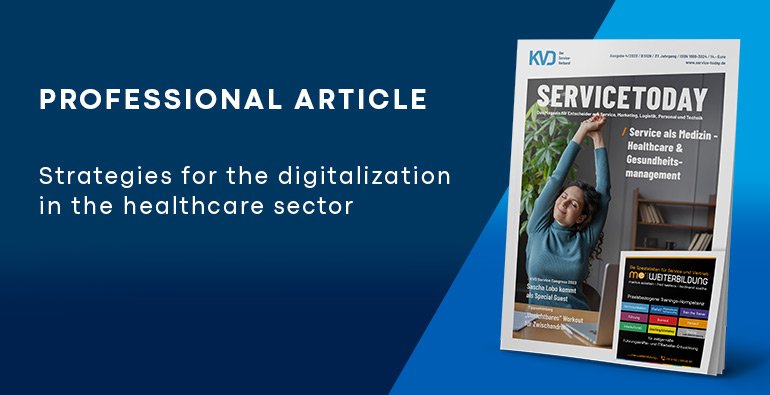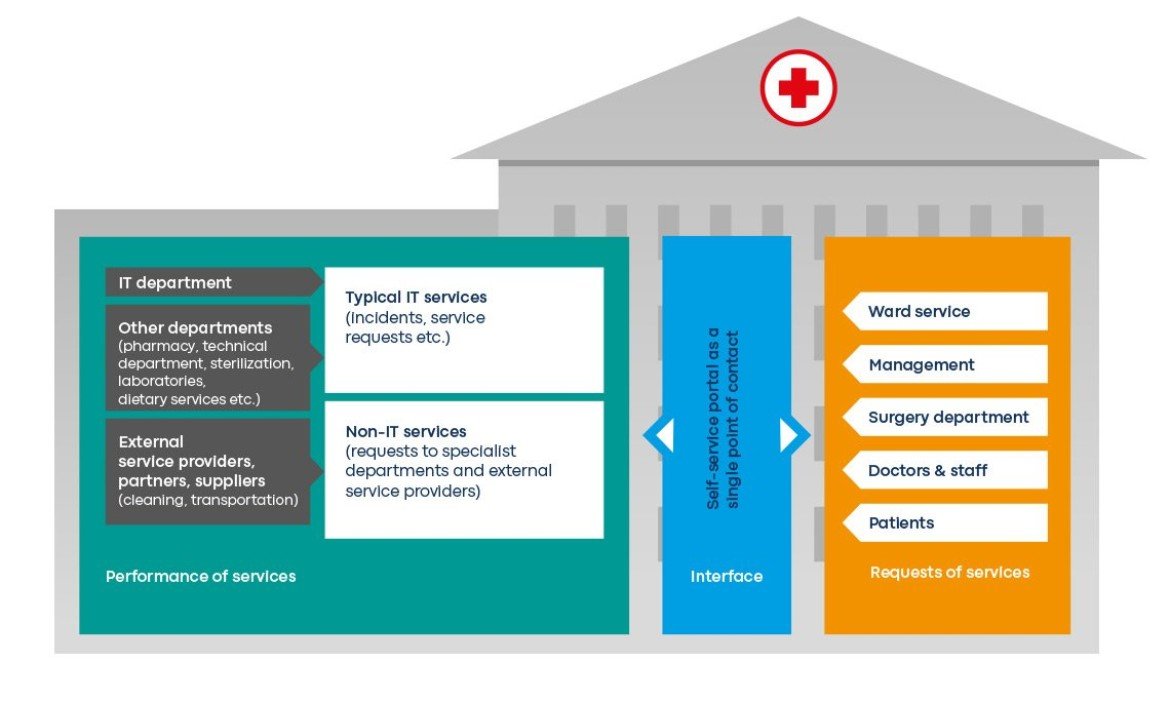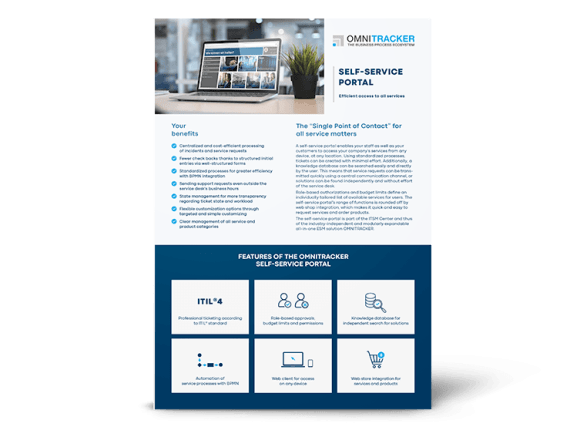Professional article: Strategies for digitalization in the healthcare sector

The digital transformation in the healthcare sector is picking up speed - perhaps too slowly for many. Nevertheless, government subsidies such as the German Hospital Future Act and the Hospital Structure Fund, as well as legal provisions such as the E-Health Act, are boosting digital expansion in clinics, care facilities and medical practices. The goal of the funding programs is to lower the barriers to digitalization from the operator's perspective, and create incentives to invest in software, hardware, specialists and expertise. The funding is about making patient data is always accessible when it is needed. Such a consistent expansion of the digital infrastructure is necessary to ensure sufficiently good patient care. At the same time, cross-institutional processing of sensitive data via distributed systems increases the need for IT and information security. In this context, the IT architecture and the service desk have a special responsibility.
IT department as the cornerstone for digital healthcare services
On the way to a modern healthcare system, the reliability of the IT department must therefore be promoted in the best possible way. The IT infrastructure forms the foundation for the electronic doctor's letter and the electronic patient file, among other documents. However, digital health and care applications are also dependent on reliable IT systems. A correspondingly high priority should be placed on the IT department and thus on the topic of IT service management (ITSM). Due to the widely perceived shortage of skilled workers in IT and care professions, efficiency is a key issue. Only with an increase in performance can IT systems be managed as smoothly as possible and made available to employees, partners, suppliers and external service providers of the respective medical facility. In addition to protecting sensitive information, the primary goal is to save working time for administrative activities, which can then be spent on patient care and treatment. This also includes communication with external partners and service providers.
The integration of systems increases both the need for IT security and the necessary application expertise. The immense turnover in healthcare facilities has made them more attractive for cybersecurity attacks and data theft. In addition, a higher degree of digitalization increases the risks of disruptions, system failures, application errors and the general effort involved in the administration of IT services.
The OMNITRACKER ITSM Center offers all the key functions required to digitally map a self-service portal with internal and external services. This includes classic ticketing features in accordance with ITIL. You are welcome to book a personal tour of our ITSM demo room, which you can then test free of charge for 30 days.
In a modern healthcare system, more technology should therefore not lead to more effort. The digitalization of medical services must result in an increase in quality and quantity through their digital transformation and at the same time shorten communication pathways. At the same time, disruptions must be reduced to a minimum. Despite all the futuristic speculation about artificial intelligence and a fully networked, patient-centric approaches—hospitals, university clinics and care facilities do not (as things stand today) need ultra-modern, immature or new systems that are almost impossible to use or even prone to errors. For managers in the IT environment, it would be desirable in some cases for IT systems to run as smoothly as possible, for forms to be filled out digitally so that scanners and fax machines are no longer needed. Even classically organized IT services noticeably relieve the workload of support teams, as manual tasks are reduced to a minimum thanks to BPMN automation.
As IT-related services will continue to increase in the future, the demand for the necessary personnel with IT expertise will also rise. Investments in supporting software solutions are worthwhile. In times of a shortage of skilled workers, service desks need help in the form of a structured IT service management concept to ensure the availability of IT systems and to be able to process IT-related requests in a reasonable amount of time. In other words, ITSM software that relieves them of some of their daily tasks. Because despite technological advancements and theoretical possibilities: In practice, it is important that standard features work. The easier it is to create and process “normal” requests, the more likely it is that the tool will be used successfully by everyone involved. Workflows with a clear structure are also easier to automate, which reduces the workload of IT teams. This increased efficiency plays a decisive role in determining whether a medical facility will survive in the long term.
Requirements for IT services and non-IT services in hospital and care environments
The IT infrastructure used must therefore by no means become a bottleneck when it comes to treatments and medical or nursing services—especially as immature IT service management and a lack of information security entail considerable economic and data protection risks if, for example, operations have to be postponed due to technical problems, treatment errors, delays in care operations or even data loss or breakdowns occur. This results in specific requirements for the IT service management tool used and the entire IT infrastructure.
In hospital and care operations, there are numerous other services that need to be requested, coordinated, carried out and documented. With a flexible ITSM tool, services outside the IT department can also be managed using standardized processes. This means that external service providers, for example, can be managed better and with fewer resources in the hospital and care environment. There is currently huge potential for expansion in the digitalization of external services.
An extended ITSM tool can also be used to manage non-IT services, for example:
- Patient transportation and transfers
- Cleaning services (special cleaning, sterilization, etc.)
- Material and equipment requirements with better resource planning, as data is tracked
- Disposal of medication
- Maintenance and repair of medical equipment
- Facility services
- Security services
- Individual services requested
It is important to ensure that all services are easily accessible for the respective target group (doctors, nursing staff, students, etc.). It must be possible to create a ticket - whether IT-related or not - easily and in just a few clicks. The same applies to external services outside of actual patient treatment and care: the easier it is to “order” a requirement, the more the workload on specialist staff is reduced. The primary goal must be to ensure that all digital services are as accessible and functional as possible.
Services that are provided internally and externally must be made easier, not more complicated, through digitalization. In order to achieve this, the software used must fulfill a number of requirements so that it can provide real relief in hospital and care operations. A self-service portal offers numerous advantages here. A self-service portal is usually started via a normal internet browser with individual (guest) access data. It acts as a central hub for all services that are offered and provided in an organization. Usually, list and tile views are combined with shortcut bars and search and filter options so that desired services can be found quickly and used easily. The requests are then processed in the backend by the relevant specialist departments, service providers, suppliers and partner companies.
A self-service portal helps you to structure services and make them centrally accessible to all parties involved. Our factsheet provides you with all the technical information about the self-service portal at a glance.
Advantages of self-service portals
-
Central and straightforward access to all available services of a facility (“single point of contact”)
-
Available around the clock (reporting incidents, requesting services, placing orders with external service providers)
-
Base filters and role concepts for greater usability, as only relevant and approved services are displayed
-
Mobile use in the browser without installation and maintenance for end users
-
Any expansion of the service portfolio (other departments, external partners, etc.)
A self-service portal can help. Even if a feature-rich self-service portal is not (yet) on the wish list for most institutions, as they are only looking for an ITSM tool, for example, the long-term goals should definitely be taken into account when choosing software. As mentioned above, IT service management forms the foundation for all other services. Ideally, the manufacturer has already gained experience in the implementation of self-service portals. Sustainability is the keyword of the hour when it comes to securing long-term profitability. Every tool change costs money; it is therefore important that all short-, medium- and long-term requirements are considered when defining the requirements. Interface integration, update capability and long-term support from the manufacturer must always be evaluated.
The tool should also be able to evaluate assets in order to assess the protection requirements of information and derive appropriate protective measures. A flexible CMDB supports this and serves as a solid basis, but it does not replace asset management. Determining the protection requirements of information values (= assets) is relevant, for example, if an ISMS in accordance with ISO 27001 is required.
Specifically, the following technical features help to reduce the workload of service desks and other service providers:
- Automation of repetitive, administrative tasks via standardized process chains that require little or no human interaction (controlling licenses, approval and release procedures or BPMN tasks)
- Status management for better resource planning and prioritization as well as greater transparency
- Use of AI for assigning ticket categories, reading relevant information and suggesting solutions from knowledge database entries
- Structured digital forms with targeted information queries for fewer callbacks
- Automated billing and documentation of services rendered
- Fast and efficient configuration via low-code elements
- Integration of third-party systems via interfaces so that tool changes are no longer necessary
Digital transformation is a process in which not all steps can take place at the same time. On the one hand, implementing and customizing software takes time. Features must be individually adapted to the respective institution, tested and consolidated in the application—existing systems must be integrated via interfaces and databases migrated. End users also have to get used to operating with new tools. The IT landscape is expanded step by step, starting with the IT department and ensuring that service requests and IT-related incidents can be responded to quickly and with the desired quality. As soon as IT service management is running reliably, the service mesh offered can be woven more tightly. This is because the concept of request, categorization, order placement, assignment, completion and billing can also be applied to services outside of IT, so that services other than the IT department can also be offered throughout the organization via a self-service portal.
The internationally recognized best practice catalog ITIL contains the guiding principle: “Start where you are”—which roughly means that every tool must fit into an existing software landscape with a specific context—and never on a so-called “greenfield site”. The challenge now is to make the best possible use of existing resources, know-how, legacy systems, etc., and to get the most out of them under the given circumstances. It is important to start with customizable, future-proof service management software and not lose sight of the overarching goal.
Helpful features in ITSM
The OMNITRACKER IT Service Management Center bundles all ticketing features. The best practice standard ITIL® serves as a framework for the efficient use of resources, high customer satisfaction and ensuring the best possible service quality. Find out more about how to optimize your value chain in our ITIL® flyer.
- Incident management for resolving hardware and software issues
- Service request management for requests of all kinds
- Role-based working with defined authorizations (everyone only has access to the data and services they really need)
- Hardware and software procurement (e.g., via an internal web store)
- Knowledge database as a basis for efficient self-service and support in day-to-day business
- Management of service contracts with response and resolution times
- Analytic tools for performance evaluation to identify optimization potentials
- Documentation and billing of IT services
- Standardized processes that are suitable for automation with BPMN
As soon as a self-service portal for IT matters has been implemented, further functions can be added (via additional function tiles and intelligent search parameters). This allows external service providers or other functional groups and task areas (HR, sterilization, OR, laundry, laboratories, technology, etc.) as well as stakeholders (students at university hospitals, partners, suppliers) to be integrated into the self-service portal. A flexibly expandable self-service portal is the key factor for efficiency, sustainability and future viability. The more smoothly these services are offered, carried out and optimized, the more time remains for the core business—the care and treatment of patients. This efficiency is necessary to ensure long-term sustainability.
About the author

Matthias Dietrich Head of Sales, OMNINET
As Head of Sales at OMNINET with over 25 years of sales experience, he is responsible for all sales activities in addition to customer relationship management. Among other things, he manages the key accounts and healthcare divisions. Matthias supports the planning and implementation of holistic digital service management solutions for clinics, care and social service providers.
This article has already been published by the service association KVD in the professional magazine SERVICETODAY.
About the magazine SERVICETODAY
The magazine SERVICETODAY is published by the service association Service-Verband KVD e.V., based in Dorsten, Germany, and published by ISB-Verlag, Waltrop, Germany. The magazine for decision-makers in service, marketing, logistics and technology has been on the market for over 30 years and provides information on management, organization and practice in service, on technical trends, their economic and organizational impact, on continual development and personnel management, on people, products and companies in the service sector.
The service association Service-Verband KVD supports its members by using its expertise and experience to identify and explain relevant service trends and developments in the areas of people, technology, processes and the environment, as well as translating them into recommendations for action. With various formats, the KVD offers its members access to knowledge, networks and interaction from practice, business and science, with which they can shape and achieve their personal and corporate success for the future.

